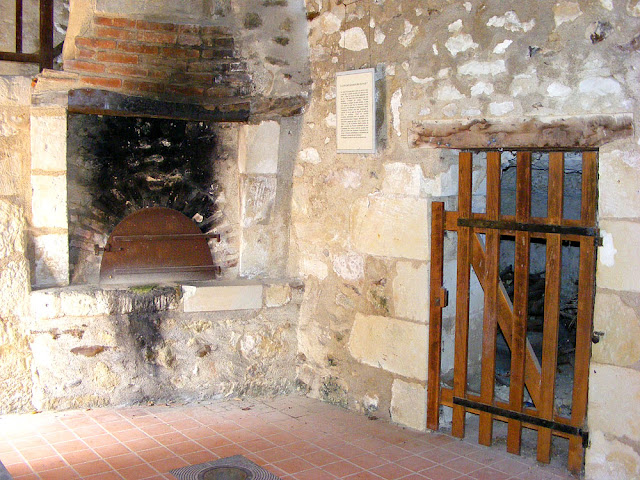Bread has been a staple in France for centuries, and central France is the
biggest producer of wheat in Western Europe.

|
| Street sign. |
If you lived in or near a village in feudal times then you were obliged to use the four banal, the communal oven, which was owned by the local lord, who charged a fee for access to the oven. The lord was responsible for the maintenance of the oven, and he had to make sure that bread was baked perfectly, otherwise he was fined. But on top of taking one sixteenth of his peasants’ grain production as a general tax, he took another one sixeenth as a fee for the use of the four banal. In addition, the lord would have owned the mill where everyone had to get their wheat ground into flour. Those who lived close to the oven were disturbed by the endless comings and goings as well as the noise and heat of the oven or ovens. Those who lived further away were annoyed that they could make the most perfect dough, but by the time they had brought it to the oven in summer it had over proved and by the time it arrived to be baked in inter it was too cold. The baker put in charge of the communal oven had to be available day and night in case someone turned up to bake their bread.

|
|
Four banal below the chateau in Le Grand Pressigny. |
The first four banal appeared in the Middle Ages in Paris near the Tour Saint Jacques [link], and they quickly spread throughout France, in populous communities becoming huge complexes with enormous and multiple ovens. These fours banaux are similar to the smaller private ones in construction and use in the 19th century. Not just bread could be cooked in these ovens, but gratinée style side dishes of vegetables would commonly be placed in the oven to brown and cook in the cooling bread oven after the loaves had been
extracted. If you ever see a dish on a modern menu that is something a la boulangere, it will be one of these homely comforting old meals. Old favourite traditional desserts such as clafoutis were also cooked this way.
After feudalism ended in France commercial bakeries started springing up everywhere and the boulangerie, named after the traditional round boule loaf, was born. At first they had big brick ovens and baked all the same breads that everyone had always baked at the fours banaux. They would also take housewives’ gratin dishes and cook them at the end of the baking day, for a small fee, as at this time many village houses did not have ovens at all and were cooking on stoves.
************************************************
For details of our private guided tours of chateaux, gardens, wineries,
markets and more please visit the
Loire Valley Time Travel
website. We would be delighted to design a tour for you.
We are also on Instagram, so check us out to see a regularly updated selection of our very best photos.
We are also on Instagram, so check us out to see a regularly updated selection of our very best photos.


2 comments:
As usual, very interesting post.
Banal is an interesting word in French with two plurals, banals and banaux. For those reading French and curious about words, the banal entry in CNRTL is worth your time.
Phew! Looks like I used the correct plural. I don't think I can take much credit though to be honest. I think I used the expression the blurb my local four banal uses :-)
Post a Comment